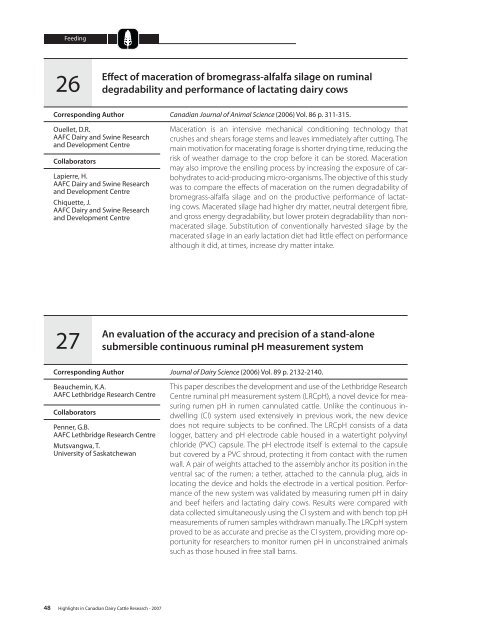A52-75-2007E.pdf - AgroMedia International Inc
A52-75-2007E.pdf - AgroMedia International Inc
A52-75-2007E.pdf - AgroMedia International Inc
You also want an ePaper? Increase the reach of your titles
YUMPU automatically turns print PDFs into web optimized ePapers that Google loves.
Feeding26Effect of maceration of bromegrass-alfalfa silage on ruminaldegradability and performance of lactating dairy cowsCorresponding AuthorOuellet, D.R.AAFC Dairy and Swine Researchand Development CentreCollaboratorsLapierre, H.AAFC Dairy and Swine Researchand Development CentreChiquette, J.AAFC Dairy and Swine Researchand Development CentreCanadian Journal of Animal Science (2006) Vol. 86 p. 311-315.Maceration is an intensive mechanical conditioning technology thatcrushes and shears forage stems and leaves immediately after cutting. Themain motivation for macerating forage is shorter drying time, reducing therisk of weather damage to the crop before it can be stored. Macerationmay also improve the ensiling process by increasing the exposure of carbohydratesto acid-producing micro-organisms. The objective of this studywas to compare the effects of maceration on the rumen degradability ofbromegrass-alfalfa silage and on the productive performance of lactatingcows. Macerated silage had higher dry matter, neutral detergent fibre,and gross energy degradability, but lower protein degradability than nonmaceratedsilage. Substitution of conventionally harvested silage by themacerated silage in an early lactation diet had little effect on performancealthough it did, at times, increase dry matter intake.27An evaluation of the accuracy and precision of a stand-alonesubmersible continuous ruminal pH measurement systemCorresponding AuthorBeauchemin, K.A.AAFC Lethbridge Research CentreCollaboratorsPenner, G.B.AAFC Lethbridge Research CentreMutsvangwa, T.University of SaskatchewanJournal of Dairy Science (2006) Vol. 89 p. 2132-2140.This paper describes the development and use of the Lethbridge ResearchCentre ruminal pH measurement system (LRCpH), a novel device for measuringrumen pH in rumen cannulated cattle. Unlike the continuous indwelling(CI) system used extensively in previous work, the new devicedoes not require subjects to be confined. The LRCpH consists of a datalogger, battery and pH electrode cable housed in a watertight polyvinylchloride (PVC) capsule. The pH electrode itself is external to the capsulebut covered by a PVC shroud, protecting it from contact with the rumenwall. A pair of weights attached to the assembly anchor its position in theventral sac of the rumen; a tether, attached to the cannula plug, aids inlocating the device and holds the electrode in a vertical position. Performanceof the new system was validated by measuring rumen pH in dairyand beef heifers and lactating dairy cows. Results were compared withdata collected simultaneously using the CI system and with bench top pHmeasurements of rumen samples withdrawn manually. The LRCpH systemproved to be as accurate and precise as the CI system, providing more opportunityfor researchers to monitor rumen pH in unconstrained animalssuch as those housed in free stall barns.48 Highlights in Canadian Dairy Cattle Research - 2007





